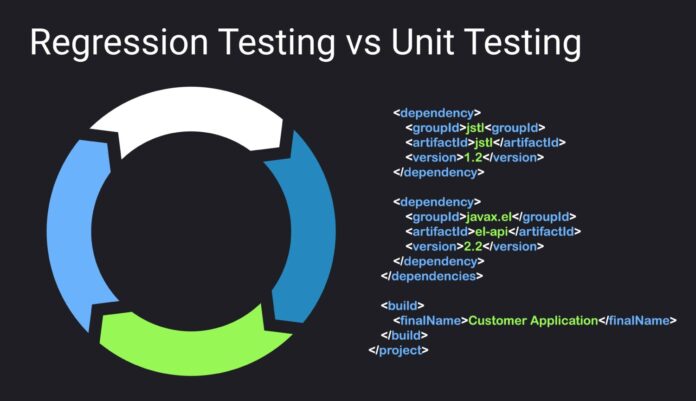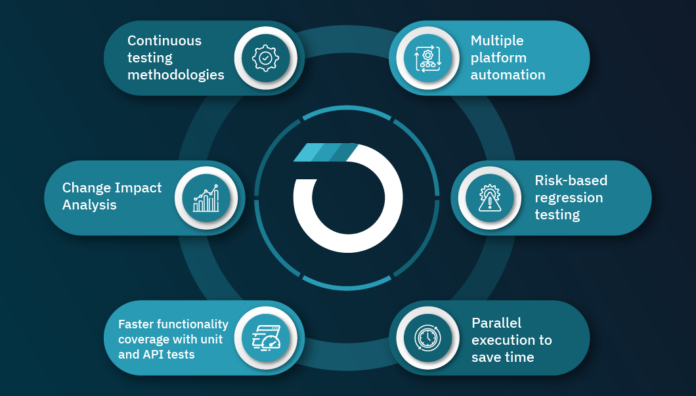Many stakeholders believe that the software development process is linear, beginning with the creation of the program, then the execution of the tests, and ending with the deployment of the code. On the other hand, many engineers are conscious that even seemingly tiny changes to a small portion of code could impact the entire application. Regression testing is the only foolproof way to ensure everything works as it should.
Regression testing ensures everything works as intended because even small changes to a single line of code can affect an application.

What does “Regression Testing” actually mean?
Regression testing determines whether newly modified code affects the app functionalities or not. The goal is to find and remove any problems that might have unintentionally been included in a new build or release candidate before the product is pushed into production.
Additionally, it’s critical to ensure that any issues that have already been fixed don’t come up again. As a result of these efforts, the amount of time spent eliminating bugs and the number of issues that reach production can be significantly decreased.
Regression testing involves running test cases to ensure the features’ functionality has not altered. These test scenarios could include unit and functional tests, verifying that the user workflow performs as expected. Unit tests ensure that methods deliver accurate results. Quality assurance staff could run these tests manually or mechanically as part of a build server.
Historically, regression tests were performed by quality assurance teams after the development team had completed their work. It soon became apparent that correcting flaws found after the release was more expensive than correcting them beforehand.
Modern developers use a method called test-driven development to create unit test cases before they write any code. On the other hand, quality assurance teams concentrate on high-level functional tests that guarantee everything functions properly.
What’s important about running regression tests?
Regression testing is now more important than ever due to the growing popularity of the Agile development methodology. Today’s enterprises use the Agile and iterative approach to software development in large numbers.
For example, many software as a service (SaaS) providers regularly update their features and add new functionalities to their products and services by introducing new software releases. These companies use regression testing to ensure that adding new features won’t impair the functionality of their core product.

What’s the difference between retesting and regression testing?
Regression testing should not be confused with retesting. Regression testing ensures that recently changed code hasn’t disrupted any device functionality. On the other hand, retesting is a word for tests carried out after a test case has discovered some problems in the product. The tests are rerun to ensure the issues have been resolved after the mistakes have been fixed.
Retesting is prioritized more than regression testing because issues have previously been found. Locating any potential issues is the goal of regression testing.
-
Price and Time
Regression testing involves rerunning tests that have already been passed; this can be tiresome for quality assurance engineers and challenging to defend to stakeholders. Particularly when the value it delivers is not completely realized, it is challenging to justify the time needed to develop and execute the tests and the high cost of test-related services and infrastructure.
-
Complexity and Maintenance
The amount and complexity of the regression tests will increase throughout a challenging software development project. It is not practical for quality assurance engineers to test manually without using a lot of time and resources because the number of test cases and the functions and processes they evaluate may easily number in the thousands.
-
Brittle tests
Nothing is more annoying than a test suite that consistently returns false positives, even though it is helpful when regression testing identifies issues before a production build. False positives from flawed tests are frustrating for all parties involved, including developers, stakeholders, and test engineers, and they may lead to doubts about the process on everyone’s behalf.
-
More resources are required
It is unquestionably necessary to perform regression tests after each and every development iteration, but justifying the time required to recreate and run the tests makes it more challenging every time. It is possible to reduce some of the load on the internal team by hiring freelance testers or teams from outside the organization carry out these test cases.

Regression Testing on LambdaTest
This digital experience testing cloud allows the users to test extensively on over 3000 real devices, operating systems and browsers, ensuring that the web apps and websites you have created work as required.
As the test suite starts growing along with the newer builds and releases, it helps the users to perform parallel tests. Furthermore the testers can leverage the online Selenium Grid capabilities to run hundreds of parallel tests simultaneously. It helps in saving time and receiving faster feedback for code commits.
Regression testing must be prioritized to ensure that all features and functions work as intended. We must ensure that the regression suites are trustworthy. Regression tests must be able to accomplish the product’s objectives each time they are run. One of the crew’s most important duties is ensuring the suite is always equipped and ready to use. Regression tests are an important part of the software development process, but there are still a lot of challenges before they can be truly helpful.
Recommended techniques to tackle the challenges of Regression Testing
You can use a variety of best practices to keep things operating smoothly and avoid the pitfalls that could cause the development process to break. Regression tests can be challenging to set up and manage, especially when resources are scarce. However, you can benefit from these best practices.
Examples of suggested practices to keep in mind include the following:

-
Automate testing
Automating tests will save time and money in the long run. Automating regression testing can significantly improve the process. If the same tests are executed repeatedly, test takers may become disinterested and lose their passion. If they become demotivated, their work quality will degrade. If you employ automated regression testing, your testers may be liberated to concentrate on the trickier case-specific tests. Automation tools can handle time-consuming testing. Software for testing can be reused, which is another factor to consider. Because of this, even if there is an upfront cost, you will continually see efficiency benefits, which means your testing software’s return on investment (ROI) will be obvious very quickly.
-
Narrow down your focus
Always focus on the software program’s most frequent use cases rather than attempting to test everything simultaneously. For instance, the best sections to start looking for chances can be user sign-ins, sign-ups, or transactions.
-
Prioritize your testing requirements
It is crucial to eliminate any tests that check whether or not deprecated features are still functional or that cover earlier iterations of the product because regression tests consume a lot of time and resources. It would help if you only put things to the test that matter.
-
Useful takeaway
The test engineers and developers who work on regression tests are completely responsible for their utility. Create simple processes that developers may utilize to convert regressions into tickets and reporting systems that can inform stakeholders.
-
Update your current regression pack regularly
Each new software update is followed by the execution of a set of test cases known as a regression pack. The requirement specifications of previous product iterations were considered when creating the scripted tests that are part of a regression pack. The package may additionally contain tests selected randomly or as needed. You are advised to keep your regression pack updated and installed at all times. Regression testing may be time-consuming, so the last thing you want to do is include tests to see if an older feature that was removed is still operational.
-
Pay attention to highly-trafficked Paths
The use cases that occur most frequently with your program involve highly-trafficked paths. Along with its most popular features, they will include your application’s core functionalities. You must thoroughly understand the primary group of customers you service, as well as the traits and practices they most frequently use. Tests must be included in your regression pack to confirm that these crucial features are performing as they should.

-
Rerun effective test cases
It’s crucial to remember to add any tests to your regression pack that has previously successfully identified bugs and problems. Alternately, since they satisfy the requirements, tests that the program consistently passes are excellent candidates for archiving.









